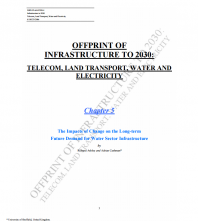
The Impact of Change on the Long-term Future Demand for Water Sector Infrastructure (Chapter 5 of “Infrastructure to 2030: Telecom, Land Transport, Water and Electricity”)

This report is Chapter 5 of the OECD publication Infrastructure to 2030: Telecom, Land Transport, Water and Electricity, published in 2006.
Background (excerpt)
Water is like no other commodity, excepting food, in that it is essential to human life. The greatest challenges facing us relate to the conditions in which we live, how we are nourished and sheltered. Water is a central issue in a world that is increasingly urbanised and has a rising population to feed and seemingly ever increasing risks.
The 20th century saw global population triple and the development of megacities. Water consumption rose, both in total amount needed and in per capita demand. Increasing pollution loads and abstractions have outstripped the assimilative capacity of ecosystems. Across the world, urbanisation has progressed through stages of ever denser habitation. Water service and infrastructure are meant to keep pace with these changes in developed countries: typically, there is an assumption that the services will follow the newest needs in terms of how people work and live. (For a fuller discussion see Juuti and Katko, 2005.) Ironically, in many of the countries, water is undervalued by the citizens who live in towns and cities because it is readily available from the tap. Once used, it is then flushed away down the toilet or the sink and is never seen or thought of again. Up to one-third of the water supplied to domestic properties is used for toilet flushing and a further significant proportion is used for purposes other than drinking; in some countries, including Australia, water used for domestic gardening can constitute more than 50% of domestic use. Worldwide, the demand for water for irrigation is now consuming some 75% of the total abstracted. In anticipation of this explosion in water use there was significant investment in the past in the provision and operation of water infrastructure, much of it in informal and low-technology groundwater pumping, some of which helps grow cheap crops exported from the developing countries to the developed world. Worryingly, much of this water use is unsustainable (New Scientist, 2006).
- Issues:
- Infrastructure, Natural Resources
- Region:
- Global
- Year Published:
- 2006
- Authors:
- Richard Ashley, Adrian Cashman
- Institution:
- Organisation for Economic Co-operation and Development (OECD)

